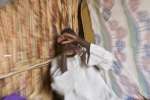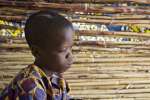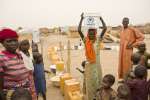Ministerial Pledging Conference on Somali Refugees. Opening Statement by António Guterres United Nations High Commissioner for Refugees. Brussels, 21 October 2015
Statements by High Commissioner, 21 October 2015
Excellencies,
Honorable Ministers,
Distinguished Delegates,
Ladies and Gentlemen,
It is a pleasure for me to welcome you to this Ministerial Pledging Conference on Somali refugees. I would like to express my deep gratitude to the European Union, notably High Representative Federica Mogherini and Commissioner for International Cooperation and Development Neven Mimica, for the invaluable support in co-hosting this event. I am also extremely pleased that we are joined here today by His Excellency the Prime Minister of Somalia, as well as his Minister of Foreign Affairs, and by the Cabinet Secretaries of Foreign Affairs and of the Interior of Kenya.
The Somali refugee situation has been going on for 23 years. At its peak, there were over two million Somali refugees living in exile – today, nearly a million remain in Kenya, Ethiopia, Yemen, Djibouti, Eritrea and Uganda. These countries have made enormous efforts to provide protection to such high numbers of refugees. Many Somalis have arrived in remote regions where host communities themselves are struggling to make ends meet, and the huge population increase has had often difficult consequences for the economies and societies of these countries.
In an expression of their strong traditions of hospitality and their respect for the principles of refugee protection, host countries came together in Addis in August 2014 and adopted the Addis Ababa Commitment towards Somali Refugees, a landmark agreement to continue to provide a safe haven to Somali refugees while stepping up the search for comprehensive durable solutions.
Somalia has been facing one of the most complex crises in recent history. Enormous challenges remain in the areas of security, basic infrastructure and access to livelihoods. Some 1.1 million Somalis are internally displaced, and others continue to leave the country to seek safety elsewhere. Somalis are among the top ten nationalities of those who have been crossing the Mediterranean to Europe in 2015.
However, there are also opportunities. The security, political and socio-economic situation in Somalia is beginning to show tangible signs of stabilization as a result of the enormous efforts of the Federal Government and the people of Somalia, with the support of AMISOM, UNSOM and the wider international community.
A growing number of refugees are repatriating spontaneously to safer areas in Somalia. When UNHCR interviewed people in Dadaab about their future plans two years ago, 82% said that they would like to return home if conditions were peaceful. Our help desks in Dadaab have received more than 10,000 inquiries about return. In a recent verification exercise, nearly 98,000 refugees were found to no longer be present in the camp, and it is likely that a meaningful number of them have spontaneously returned to Somalia.
With this momentum, a pilot voluntary return programme was established last December under the framework of the Tripartite Agreement between Kenya, Somalia and UNHCR. It aims to support refugees who wish to return home to one of the nine districts in Somalia where conditions are considered relatively safe. Some 5,200 people have returned under this programme since it started, and UNHCR and partners are carrying out extensive protection and post-return monitoring in the communities of origin. We are now getting ready to move into the enhanced phase of this operation, which will aim to assist 135,000 refugees to return to Somalia between January 2016 and December 2017.
Distinguished Delegates,
The plan we are presenting here today builds on the framework set by the Addis Ababa Commitment, to pursue a comprehensive solutions approach that remains nevertheless sensitive to refugees' continued need for protection. The Integrated Action Plan consists of interrelated humanitarian and development proposals that will be implemented in both countries and link the return intention of refugees while still in exile with their needs for sustainable reintegration back home.
The Governments of Kenya and Somalia have enhanced their common mechanisms for the coordination of return and reintegration activities in areas considered safe. I would like to commend their collaboration under the framework of the Tripartite Commission to produce this Plan of Action and work jointly towards enhancing opportunities for the voluntary repatriation of Somali refugees in conditions of safety and dignity.
Around the world, sustainable voluntary return home is the solution which most refugees prefer for themselves and their families – and Somalis are no exception. But for this to be sustainable, returnees need better access to shelter, social services and livelihoods. The integrated action plan aims to help create these conditions for sustainable reintegration, through community-based investments targeting high-return areas where conditions are considered safe. It will be implemented in line with national priority programmes such as the Somalia Humanitarian Response Plan and the Peace Building and State Building of the New Deal Compact.
The plan also targets Kenya, which has generously hosted hundreds of thousands of Somali refugees for nearly a quarter of a century. At the height of the famine and conflict-induced humanitarian crisis in Somalia in 2011, the number of Somali refugees who received protection in Kenya rose to more than half a million. Today, the number of registered refugees still stands at over 420,000.
The prolonged presence of such a large population of refugees has had a significant impact on hosting communities in Garissa, Dadaab, Kakuma and even Nairobi. The integrated action plan proposes investments to rehabilitate refugee hosting areas and to support the resilience of the host communities. Interventions also aim at increasing livelihoods and educational opportunities that will prepare refugees for the future and give them the skills to build peaceful, vibrant communities upon their return to Somalia. And, importantly, as security in some of the major refugee hosting areas has deteriorated in recent years, the Government of Kenya also requires urgent support to enhance security arrangements in the Dadaab camps and continue to maintain the civilian and humanitarian character of asylum.
The Kenya component of the plan also includes the upgrade of the road from Modika via Dadaab to Liboi on the border with Somalia. These road improvements will help to promote socio-economic cohesion and integration within refugee hosting areas and between Kenya and Somalia. The Government of Kenya has started to mobilize financing from various bilateral and multilateral development institutions, and I hope donors will complement that support with additional funding.
It is clear that for both of the components of this plan, in Kenya and in Somalia, humanitarian assistance alone will not meet the needs. We are therefore counting on the support from development actors – supported by development budgets – to ensure the sustainability of these interventions.
Ladies and Gentlemen,
No one will deny that there is still a long way to go until real peace can return to Somalia and conditions will stabilize sufficiently for large-scale return. But it is precisely because times are difficult that it's so important to support Somalia and Somali refugees today, and to boost the resilience and security of host communities in Kenya.
Investing in effective and sustainable return to safe areas in Somalia, while preserving asylum space and supporting refugees' access to livelihoods and skills development, are vitally important to the success of on-going efforts to stabilize Somalia and indeed the whole region.
I therefore hope that, as the global refugee crisis has moved into the center of the international community's attention, States and development partners will take a holistic approach to the problem. Doing so will require us to tackle the many different factors that contribute to the record numbers of people on the move today. Given that Somali refugees make up the world's second largest protracted refugee situation, addressing their continued needs for protection in the region and enhancing our efforts to support sustainable voluntary return is absolutely essential. At a time when the world's attention – and its resources – are stretched so thinly across an ever-growing range of refugee crises, we must remain determined to address not only their symptoms, but also their causes. Giving refugees a perspective for the future in their country of origin is one of the best investments one can make in this situation, and I very much hope that the international community will seize this opportunity and pledge their support to this initiative.
Thank you very much.








































